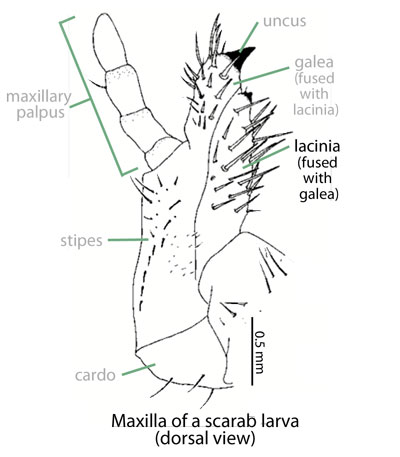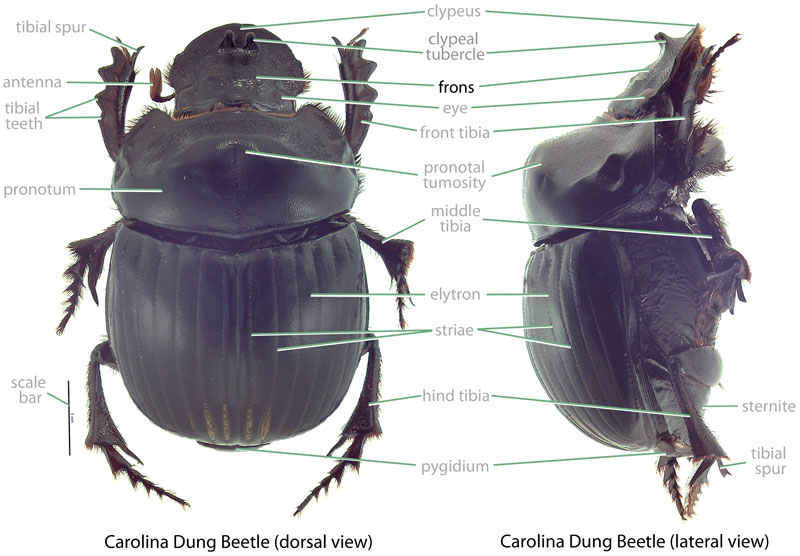Potential Invader
none known
Family: Scarabaeidae Subfamily: Rutelinae Genus: Popillia Species: Popillia quadriguttata (Fabricius, 1787)
none available
Total body length 8.0–11.0 mm (0.31–0.43 in). Body oval-shaped. Color shining green, sometimes with reddish sheen; elytraelytra:
the hardened and chitinous wing-cover of a beetle that protect and overlie the flight wing
shiny brownish. Clypeusclypeus:
part of the head anterior to the frons; the most anterior portion in dorsal view
 rounded; apexapex:
rounded; apexapex:
point or edge furthest from the body
somewhat recurvedrecurved:
bending backwards
; narrowing toward apexapex:
point or edge furthest from the body
. Front claw toothed, male with toothed claw more robust than in female. Pronotumpronotum:
the dorsal surface of the thorax
 with dense punctationpunctation:
with dense punctationpunctation:
relating to a punctate surface texture
near anterioranterior:
the front or forward; opposite of posterior
border; punctures distinct. Pygidiumpygidium:
the last abdominal segment, usually exposed, not completely covered by the elytra
 with 2 vaguely oval-shaped patches formed by dense whitish hairs (sometimes absent in worn specimens).
with 2 vaguely oval-shaped patches formed by dense whitish hairs (sometimes absent in worn specimens).
Undescribed. For Popillia spp. (Ritcher, 1966Ritcher, 1966:
Ritcher P. 1966. White grubs and their allies: a study of North American scarabaeoid larvae. Oregon State University Monographs, Studies in Entomology 4: 1-219.): Grub C-shaped, not hump-backed, cylindrical, whitish. Maxillamaxilla:
set of paired mouthparts located posterior to the mandibles
with galeagalea:
outer branch or lobe of the maxilla
 and lacinialacinia:
and lacinialacinia:
inner portion of the maxilla fused or nearly so. Fronsfrons:
fused or nearly so. Fronsfrons:
part of the head generally positioned between the eyes (posterior to the clypeus and anterior to the vertex) and visible dorsally
 sparsely punctatepunctate:
sparsely punctatepunctate:
a surface texture characterized by numerous puncture-like marks or impressions, often described in terms of puncture size, shape, and density
. Labrumlabrum:
upper lip that covers the mandibles and is located ventrally relative to the clypeus
 asymmetrical. Claws sharply pointed. Spiraclesspiracles:
asymmetrical. Claws sharply pointed. Spiraclesspiracles:
opening on the abdomen or thorax through which air enters and exits the body
 on 7th and 8th abdominal segments nearly equal in size. Dorsa of 9th and 10th abdominal segments not fused. Septulaseptula:
on 7th and 8th abdominal segments nearly equal in size. Dorsa of 9th and 10th abdominal segments not fused. Septulaseptula:
narrow bare area(s) of raster
shaped like an equilateral triangle, palidiapalidia:
paired group(s) of recumbent (reclining) spines, usually occurring in rows; part of the raster
strongly diverging posteriorly; each palidiumpalidium:
paired group(s) of recumbent (reclining) spines, usually occurring in rows; part of the raster
with 5–7 (rarely 8) long, ensiformensiform:
sword-shaped; long and narrow in shape with pointed tip and sharp edges
pali. Venter of last abdominal segment with 14 or more preseptular, hooked setaesetae:
small, hair-like structure
.
East Asia. This species is known from a wide area of East Asia, ranging from North Vietnam, China, Taiwan, to Korea (Lee et al., 2007Lee et al., 2007:
Lee D, Choo H, Smitley D, Lee S, Shin H, Kaya H, Park C, Park J. 2007. Distribution and adult activity of Popillia quadriguttata (Coleoptera: Scarabaeidae) on golf courses in Korea. Journal of Economic Entomology 100: 103-109. DOI: doi.org/10.1603/0022-0493(2007)100[103:DAAAOP]2.0.CO;2). Records from the Russian Far East are also known (Chen et al., 2014Chen et al., 2014:
Chen R, Klein M, Li Q, Li Y. 2014. Mass trapping Popillia quadriguttata using Popillia japonica (Coleoptera: Scarabaeidae) pheromone and floral lures in northeastern China. Environmental Entomology 43: 77-81. full text (accessed 2015)).
(Lee et al., 2002Lee et al., 2002:
Lee D, Choo H, Chung J, Lee S, Sagong Y. 2002. Hosts plants of Popillia quadriguttata (Coleoptera: Scarabaeidae). Korean Journal of Applied Entomology 41: 15-19.): Like the related Japanese Beetle (Popillia japonica), this species is known to feed on a broad range of host plants from a broad range of plant families. Recorded hosts of adult beetles include: Acalypha australis, indigo bush (Amorpha fruticosa), Artesmia princeps, feather fingergrass (Chloris virgata), Asian hazel (Corylus heterophylla), Dioscorea septembola, soybean (Glycine max), bush clover (Lespedeza cyrtobotrya), Amur privet (Ligustrum obtusifolium), spicebush (Lindera erythrocarpa), Lysimachia burystachys, Herlicteres angustifolia, paradise apple (Malus pumila), Persicaria senticosa, bracken (Pteridium aquilinum), Pyrus spp., sargent cherry (Prunus sargentii), Rhapontica uniflora, Asian raspberry (Rubus parvifolius), bao li (Quercus serrata), Korean willow (Salix koreansis), lyreleaf nightshade (Solanum lyratum), Siberan elm (Ulmus pumila), Japanese wisteria (Wistaria floribunda), Zanthoxylum spp., and corn (Zea mays). LarvaeLarvae:
the immature form of an insect; in scarabs, also called grub or white grub; preceded by the egg stage, followed by the pupal stage
 mostly feed on grass roots, though soybeans are also known as hosts (Chen et al., 2014Chen et al., 2014:
mostly feed on grass roots, though soybeans are also known as hosts (Chen et al., 2014Chen et al., 2014:
Chen R, Klein M, Li Q, Li Y. 2014. Mass trapping Popillia quadriguttata using Popillia japonica (Coleoptera: Scarabaeidae) pheromone and floral lures in northeastern China. Environmental Entomology 43: 77-81. full text (accessed 2015)).
(Lee et al., 2002Lee et al., 2002:
Lee D, Choo H, Chung J, Lee S, Sagong Y. 2002. Hosts plants of Popillia quadriguttata (Coleoptera: Scarabaeidae). Korean Journal of Applied Entomology 41: 15-19.): In Korea, this species was found to fly most actively between noon and 2 p.m., with particularly vigorous activity occurring on sunny days after a rain. Adults are strictly diurnaldiurnal:
active during daylight hours
and do not come to lights at night. Adults were encountered from late June to late July with abundance peaking in early July. Notably, the appearance of adults corresponded with the onset of the Korean rainy season.
Significant. This species is known to damage a variety of commercially valuable plants, both as adults (Chen et al., 2014Chen et al., 2014:
Chen R, Klein M, Li Q, Li Y. 2014. Mass trapping Popillia quadriguttata using Popillia japonica (Coleoptera: Scarabaeidae) pheromone and floral lures in northeastern China. Environmental Entomology 43: 77-81. full text (accessed 2015)) and as larvaelarvae:
the immature form of an insect; in scarabs, also called grub or white grub; preceded by the egg stage, followed by the pupal stage
 (Lee et al., 2002Lee et al., 2002:
(Lee et al., 2002Lee et al., 2002:
Lee D, Choo H, Chung J, Lee S, Sagong Y. 2002. Hosts plants of Popillia quadriguttata (Coleoptera: Scarabaeidae). Korean Journal of Applied Entomology 41: 15-19.). In China, this species is considered a major pest of soybean (Glycine max). Adults cause significant damage to foliage, buds, and stems, while larvaelarvae:
the immature form of an insect; in scarabs, also called grub or white grub; preceded by the egg stage, followed by the pupal stage
 destroy roots (Chen et al., 2014Chen et al., 2014:
destroy roots (Chen et al., 2014Chen et al., 2014:
Chen R, Klein M, Li Q, Li Y. 2014. Mass trapping Popillia quadriguttata using Popillia japonica (Coleoptera: Scarabaeidae) pheromone and floral lures in northeastern China. Environmental Entomology 43: 77-81. full text (accessed 2015)). In Korea, Popillia quadriguttata is a pest of corn (Zea mays) and fruit trees. LarvaeLarvae:
the immature form of an insect; in scarabs, also called grub or white grub; preceded by the egg stage, followed by the pupal stage
 are recognized as important turf-grass pests, particularly on golf courses. The larvaelarvae:
are recognized as important turf-grass pests, particularly on golf courses. The larvaelarvae:
the immature form of an insect; in scarabs, also called grub or white grub; preceded by the egg stage, followed by the pupal stage
 cause direct damage by feeding on the roots of turf-grass, and further harm is inflicted when wildlife dig up turf in search of grubs (Lee et al., 2002Lee et al., 2002:
cause direct damage by feeding on the roots of turf-grass, and further harm is inflicted when wildlife dig up turf in search of grubs (Lee et al., 2002Lee et al., 2002:
Lee D, Choo H, Chung J, Lee S, Sagong Y. 2002. Hosts plants of Popillia quadriguttata (Coleoptera: Scarabaeidae). Korean Journal of Applied Entomology 41: 15-19.).
Not established or recorded. This species has not been recorded in Hawaii, but because it is a widespread pest in East Asia, it has a high potential for introduction.
Not established or recorded. This species has not been recorded in Guam, but because it is a widespread pest in East Asia, it has a high potential for introduction.
With a native range that spans from tropical Vietnam to the cold temperate forests of the Russian Far East, this beetle is a biosecurity threat not only to Hawaii and Guam, but also to the contiguous U.S. If established, Popillia quadriguttata could become a pest of corn and soybeans in the midwestern U.S., a region similar in climate to northeastern China and Korea. Because adults of this species congregate on foliage, they could be transported on nursery stock. It is also plausible that larvaelarvae:
the immature form of an insect; in scarabs, also called grub or white grub; preceded by the egg stage, followed by the pupal stage
 or eggs could be transported in turf grass or plant roots, the probable manner of the U.S. introduction of the related Popillia japonica (Krischik, 2011Krischik, 2011:
or eggs could be transported in turf grass or plant roots, the probable manner of the U.S. introduction of the related Popillia japonica (Krischik, 2011Krischik, 2011:
Krischik V. 2011. Japanese beetle management in Minnesota. Minnesota Department of Agriculture, University of Minnesota Extension Service. Available from http://www.extension.umn.edu/garden/insects/find/japanese-beetles/ (accessed 2015).).
Two Popillia species are recorded from Hawaii and Guam: the well-known Popillia japonica and Popillia lewisi. Popillia quadriguttata is quite similar to both. These species can be separated by examination of the pronotal punctationpunctation:
relating to a punctate surface texture
(P. quadriguttata with dense, distinct punctures near the anterioranterior:
the front or forward; opposite of posterior
border versus P. lewisiwith sparse, indistinct punctures near the anterioranterior:
the front or forward; opposite of posterior
border), pygidiumpygidium:
the last abdominal segment, usually exposed, not completely covered by the elytra
 (P. quadriguttata with two vaguely oval-shaped patches of white setaesetae:
(P. quadriguttata with two vaguely oval-shaped patches of white setaesetae:
small, hair-like structure
versus P. lewisiwith crescent-shaped patches), clypeusclypeus:
part of the head anterior to the frons; the most anterior portion in dorsal view
 (P. quadriguttata with clypeusclypeus:
(P. quadriguttata with clypeusclypeus:
part of the head anterior to the frons; the most anterior portion in dorsal view
 narrowing at apexapex:
narrowing at apexapex:
point or edge furthest from the body
, somewhat recurvedrecurved:
bending backwards
versus P. japonica with clypeusclypeus:
part of the head anterior to the frons; the most anterior portion in dorsal view
 barely narrowed at apexapex:
barely narrowed at apexapex:
point or edge furthest from the body
, strongly recurvedrecurved:
bending backwards
), and often size (P. quadriguttata at 8.0–11.0 mm [0.31–0.43 in] versus P. japonica at 9.0–13.7 mm [0.35–0.54 in]).
Trichius biguttatus Fabricius, Popillia bogdanowi Ballion, Popillia castanoptera Hope, Popillia chinensis Frivaldszky, Popillia dichroa Blanchard, Popillia frivaldszkyi Kraatz, Popillia purpurarescens Kraatz, Popillia ruficollis Kraatz, Popillia sordida Kraatz, Popillia straminipennis Kraatz, Popillia uchidai Niijima and Kinoshita
In Hawaii, this species represents a new invasiveinvasive:
a species that has recently arrived to a new location, usually via human activity, causing notable economic and/or ecological damage
species. Prevent the spread of this species by reporting your observation at our iNaturalist project.